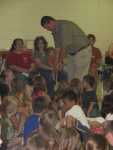Animal mysteries unveiled in summer reading program

By Crystal D. Hancock
Nevada Daily Mail
Kevin Badgley of the Missouri Department of Conservation provided an animal mystery program for the Nevada Public Library's Summer "Wowsome Wednesdays" program held at the Nevada Community Center.
"There are so many mysteries associated with animals in this area that you and I don't often think about. However, there are also various clues that most animals leave behind, allowing us to somewhat solve their mysteries," Badgley told the parents and children who attended this week's program. "I bet that each and every one of you kids can think of at least one example of a clue that an animal may leave behind."
With this thought, the children slowly started raising their hands and shouting out clues that they thought an animal could leave, such as snakes shedding skins and birds losing feathers, building nests and leaving bird seed scattered all around a bird house. The children also pointed out that ants sometimes leave their ant hills and beavers leave dams that they probably worked very hard to construct.
Badgley shared much knowledge with the program participants, while making learning about animals fun. For example, furbearers are animals that are hunted or trapped for their furred skins. They share the physical qualities of other mammals, but have unique habits.
According to the Missouri Department of Conservation, furbearers are widespread in Missouri. They are known as a group of mammals with some common characteristics. Much like other aggregations of creatures, such as waterfowl, upland game, or cavity nesters, the furbearers of Missouri are a diverse group of animals. Furbearers have been hunted in North America for more than 11,000 years for food and clothing. A common furbearer in our area is the opossum. It is the only marsupial in North America and is among the most primitive of living animals. They are usually only active at night and are often seen along highways in the glare of automobile headlights as they feed on animals killed on the road.
The beaver, another fairly common furbearer in our area, is the largest rodent in North America, sometimes reaching 60 to 70 pounds or more. Beavers live in streams, rivers, lakes, ponds and swamps. Sometimes dams are constructed with sticks, rocks, logs and mud. The pond they build provides them with protection. They are also strictly vegetarians, eating leaves and twigs.
"There are so many things to learn about the animals in our world. Some may think that animals commonly seen in this area are simple. However, there is much more to them than meets the eye. Every animal, in fact, is extremely complex in its own way, learning about them doesn't have to be so complex," Badgley said.
Badgley displayed this by bringing out the educational, yet entertaining side of animals to the kids. He shared a snake skin with the audience and some furs as well. The kids were in awe at all the new characteristics and traits they learned about the various animals that Badgley talked with them about.
